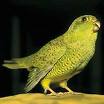
| Amazon Expedition Travel
|
 |
|
|
|

| User Functions
|
|
|
Don't have an account yet? Sign up as a New User
|
|

| Help support this site!
|
|
|
Help support this site... your donations are needed to support research, conservation, and rescue efforts.
|
|

|
 |
| Night Parrot - near extinction - confirmed in Australian Outback |
 |
Friday, February 16 2007 @ 03:37 PM UTC
Contributed by: Paul Brennan
Views: 9900
|

 Bad news for one night parrot, good for species Bad news for one night parrot, good for species
Greg Roberts
February 16, 2007
ONE "dead" parrot in Queensland has risen phoenix-like from the ashes, as another has been given its last rites. The Australian has learned that National Parks and Wildlife Service officers have found a dead night parrot in the state's far west, confirming the survival of Australia's rarest bird.
In a discovery of international significance, the parrot was found in November in the Diamantina Lakes region after it flew into a barbed-wire fence. The Government has kept the find secret to avoid birdwatchers searching for night parrots while it does a survey to find more.
A road-killed night parrot found in 1990 near Boulia, in northwest Queensland, by Australian Museum scientists was the first confirmed record of the species since 1912. That find forced millionaire businessman Dick Smith to part with a $50,000 reward he had offered for evidence that it existed.
Both the Boulia parrot and the latest bird were headless.
An unsubstantiated report of night parrots in Western Australia's Pilbara in 2005 held up a planned $2 billion iron ore mine.
The night parrot is Australia's only nocturnal parrot.
It feeds and nests on the ground and once widely inhabited the outback.
Its population crashed in the 19th century for reasons that remain obscure.
News of the discovery emerged as doubts mounted over claims that a previously unknown parrot had been found in the rainforests of southern Queensland. Naturalist John Young claimed to have photographed the so-called blue-browed fig-parrot at an undisclosed location.
The Australian revealed this week that the Queensland Government had dissociated itself from Mr Young after a leading authority on forensic photography, Gale Spring, cast doubt on his photograph.
Mr Young has also claimed his find would be proved by DNA analysis of feathers he had collected from baby parrots.
However, The Australian has learned that no feathers have been sent to the CSIRO or to any Australian museum. Mr Young would not comment.
|
|
|
|

|

|

